AARP Hearing Center


How can local policymakers and practitioners make the case to funders, business leaders and residents to increase transit options in their communities?
How can municipalities pay for new transit options, extensions to current transit lines, and maintenance for existing systems?
What is a Complete Street?
Beth Osborne, director of Transportation for America, answers those questions and helps navigate challenging transportation issues. An expert in federal, state and local government transportation policy, Osborne has also served in senior roles at the U.S. Department of Transportation, the U.S. Senate, and the Southern Governor’s Association.
Watch each of the three subject-specific videos below — or scroll down to see all three segments in one video.
Lesson 1: Funding Transit
Transit funding can be stitched together in as many ways as there are funding options — among them, federal programs, state and local revenue streams, or options that are unique to a region or community, such as a sales tax or ballot initiative.
Lesson 2: Making the Case for Transit
Good transit and transit options benefit businesses, communities and people of all ages by providing access to jobs, supporting local retailers, lowering monthly expenditures for families, increasing property values, and generally improving health and wellness.
Lesson 3: Complete Streets
What makes a street a Complete Street? How do Complete Streets contribute to the economic health, well-being and vitality of a community? Learn about the components of a Complete Street and how such roadways improve safety and incentivize investment.
The Complete Lesson: Transportation Topics
Watch all three videos with a single click.
Related Links
- Article: Lessons from Livability Leaders
- AARP Livable Communities Transportation Workshop
- Bicycling
- Complete Streets
- Transportation
- Walkability
- More Livable Lesson Videos
The videos on this page were created by an external organization so might not reflect AARP’s public policies or advocacy positions, which can be found in the AARP Policy Book. The videos were filmed in July 2020 | Page published November 2020































.jpg?crop=true&anchor=13,195&q=80&color=ffffffff&u=lywnjt&w=2008&h=1154)



























